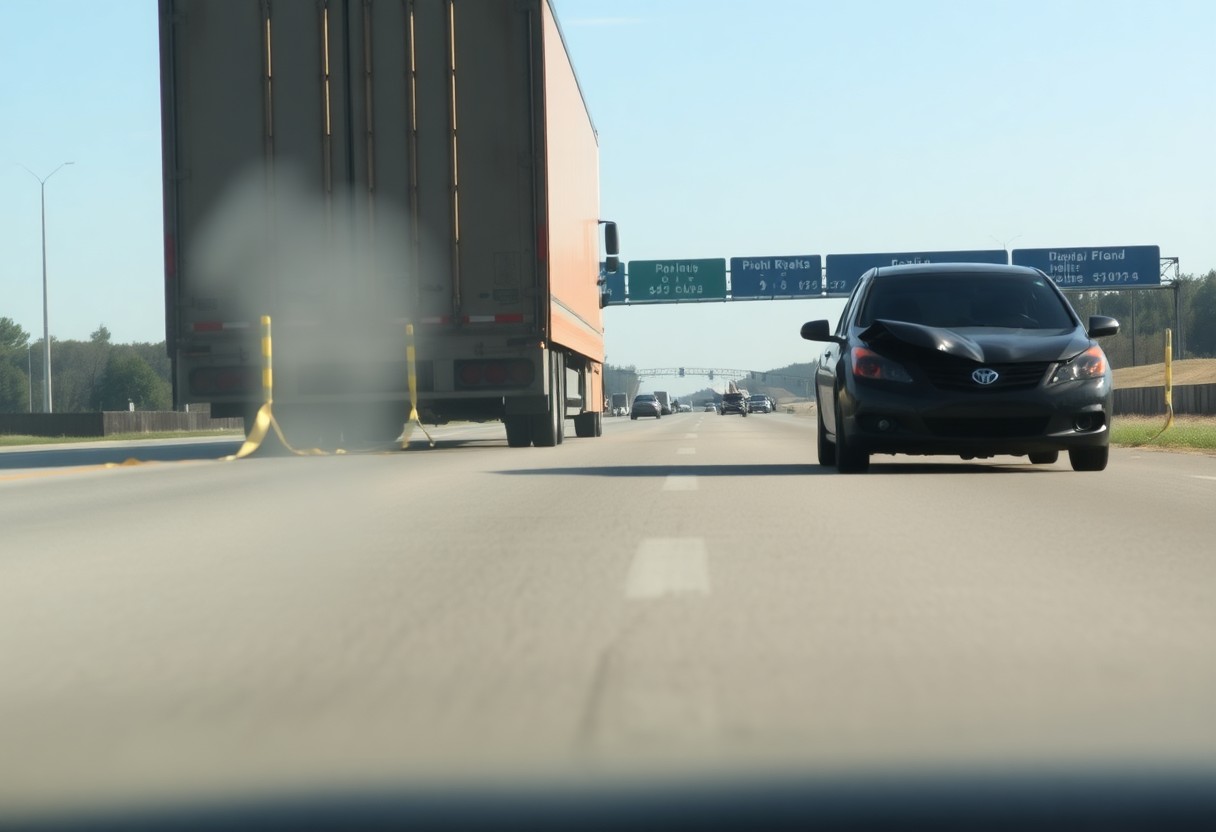Most people are unaware of the complexities involved in determining liability after a truck accident. If you find yourself in this situation, it’s vital to act swiftly to gather the necessary evidence to establish fault. In this guide, you will learn effective steps to collect crucial information, engage with key witnesses, and leverage police reports to strengthen your case. By following these steps, you can confidently navigate the claims process and ensure your rights are protected in Alabama’s legal landscape.
Key Takeaways:
- Gather Evidence: Collect vital information such as photos, witness statements, and police reports to establish the circumstances of the accident.
- Understand Negligence: Identify how negligence played a role in the accident, including driver behavior, vehicle maintenance, and regulations compliance.
- Consult Legal Expertise: Seek guidance from an experienced attorney who specializes in truck accidents to effectively navigate the legal process and advocate for your rights.
Understanding Fault in Truck Accidents
For anyone involved in a truck accident in Alabama, understanding fault is vital. Fault determines who is liable for damages and can significantly affect your ability to recover compensation. In truck accidents, multiple parties may share fault, including the truck driver, trucking company, and even vehicle manufacturers, making it vital to assess each party’s role in the incident.
Definition of Fault
With regard to truck accidents, fault refers to the legal responsibility assigned to individuals or entities that cause an accident through negligence or wrongdoing. Establishing fault involves examining actions leading up to the accident, determining whether the involved parties acted reasonably, and reviewing applicable laws governing the situation.
Common Causes of Truck Accidents
To understand how truck accidents occur, you should know that several common causes contribute to these incidents. These may include distracted driving, fatigue, poor vehicle maintenance, and adverse weather conditions. Each factor plays a significant role in the likelihood of an accident and can often be linked to the fault determination process.
For instance, distracted driving, such as using a mobile device, poses a significant risk as it diverts the truck driver’s attention from the road. Driver fatigue is another major cause, as long hours behind the wheel can lead to serious lapses in judgment. Additionally, poor vehicle maintenance can result in brake failures or tire blowouts, making it vital for trucking companies to adhere to safety regulations. Understanding these factors will help you assess potential fault in your specific accident scenario.
Key Factors in Proving Fault
One of the primary elements in establishing fault in an Alabama truck accident involves evaluating several key factors that can determine accountability. Essential aspects to consider include:
- driver negligence
- vehicle maintenance records
- road conditions
- traffic laws
Knowing these factors can significantly impact the outcome of your case.
Driver Negligence
Some instances of driver negligence can involve distracted driving, speeding, or driving under the influence. When assessing fault, you will need to demonstrate that the truck driver’s actions fell below the expected standard of care.
Vehicle Maintenance Records
Even when a driver is not at fault, inadequate vehicle maintenance can still play a significant role in an accident. You should look into the maintenance history of the truck involved, as poor upkeep can contribute to accidents.
The vehicle maintenance records should include details on any repairs, inspections, and service schedules. If the truck had known issues that were not addressed, this negligence may indicate a lack of duty of care. Additionally, if the maintenance records reveal that vital components were overlooked or not regularly checked, this could be a key factor in proving fault. Strong documentation can help demonstrate that the mechanical failures significantly contributed to the accident, holding truck owners and operators accountable.
Collecting Evidence
Keep a detailed record of all relevant evidence following your truck accident. This includes photographs, video footage, vehicle damage, and any relevant documents such as police reports and medical records. Gathering this information promptly can significantly bolster your case and prove fault in Alabama.
Scene of the Accident
Now that you are safe, prioritize capturing the scene of the accident. Take pictures from multiple angles, focusing on the positioning of the vehicles, any visible traffic signals, and road conditions. Providing a visual representation of what occurred can be instrumental in establishing fault.
Witness Statements
To strengthen your claim, collect witness statements who observed the accident. Their perspectives add an unbiased account that may affirm your version of events, aiding in proving who is at fault.
Statements from witnesses can significantly enhance your case. Aim to gather contact information and a brief summary of what they saw from each witness. Their observations on things like traffic signals, vehicle speeds, and behaviors leading up to the accident can provide key insights that support your claim. If possible, get written statements or recorded interviews to ensure their accounts are preserved. This detailed information can be influential in negotiations with insurance companies or in court.
Importance of Police Reports
Now, understanding the importance of police reports in an Alabama truck accident is crucial for establishing fault. These reports provide an official account of the incident, including vital details such as witness statements, vehicle positions, and the officers’ observations. This documentation can substantiate your claims during negotiations with insurance companies or in court, serving as a key piece of evidence to support your case.
Obtaining the Accident Report
Clearly, obtaining the accident report is your first step after the crash. You can request a copy from the local police department or online, often for a nominal fee. Be sure to have details like the report number, date, and location of the accident on hand to streamline the process.
Analyzing the Report for Fault
Any thorough analysis of the report should focus on the specific details that indicate fault. Look for information such as traffic violations, statements from witnesses, and the final conclusions drawn by the responding officers. These elements can shed light on liability and bolster your position.
Another aspect to consider in analyzing the report is the diagrams and photographic evidence included, which can help clarify how the accident occurred. Pay attention to any traffic citations issued, as they can significantly strengthen your argument regarding fault. Additionally, examining witness accounts for consistencies or discrepancies can provide further insight. Notably, any indication of a driver’s negligence or violation of traffic laws can be pivotal in determining fault and enhancing the strength of your claims.
Working with Insurance Companies
Not understanding how to approach insurance companies can hinder your ability to prove fault in a truck accident. It’s crucial to be prepared and informed about the procedures, policies, and tactics the insurers might use during your claim process.
Filing an Insurance Claim
To file an insurance claim effectively, gather all necessary documentation, including police reports, medical records, and photographs from the accident scene. Submit your claim promptly to ensure timely processing and notify all parties involved about your actions to create a clear record.
Communicating Fault Effectively
If you want to communicate fault effectively, clearly articulate the circumstances surrounding the accident, citing evidence and using objective language. Provide a detailed account of the events that led to the collision while remaining calm and focused.
Insurance representatives will often assess the liability based on the details you provide. Ensure your account is fact-based and free of emotional bias, as this will aid in establishing a clear narrative of the events. Being concise and sticking to the facts not only strengthens your position but also simplifies the claims process for both you and the insurer.
Legal Considerations
Despite the complexities that arise in a truck accident case, understanding the legal framework is vital for proving fault effectively. Be aware that different factors such as insurance policies, state laws, and the specifics of your accident can all influence the legal process and your claim outcome. Consulting with a legal expert familiar with Alabama truck accident laws can significantly aid your efforts to establish fault and secure the compensation you deserve.
When to Seek Legal Advice
Now is the time to seek legal advice if you have been involved in a truck accident that caused injury or significant property damage. Engaging a knowledgeable attorney early in the process can help you navigate the complexities of gathering evidence, understanding your rights, and addressing the insurance claims process effectively. This proactive step is necessary in ensuring that your interests are protected.
Understanding Liability Laws in Alabama
Legal definitions of fault in Alabama can be quite specific, so it’s important to familiarize yourself with these regulations. Alabama operates under a “contributory negligence” rule, meaning if you are found to be even slightly at fault for the accident, you may be barred from recovering any compensation. It’s critical to gather evidence and present a strong case to demonstrate the other party’s negligence. This includes witness statements, photographic evidence, and police reports, as these elements can be pivotal in proving fault.
Understanding the contributory negligence rule in Alabama is necessary for your case. This law stipulates that if you are found to share any degree of fault for the accident, even as little as 1%, you could potentially lose your right to receive compensation for your injuries or damages. This makes it imperative to effectively present your case and prove the other party’s liability. Gather comprehensive evidence, such as witness accounts, traffic camera footage, and accident reconstruction data, as these pieces can strengthen your argument and help protect your interests in court.
Final Words
Upon reflecting on how to prove fault in an Alabama truck accident, you should emphasize the importance of gathering evidence, documenting the scene, and understanding local traffic laws. By following the step-by-step guide, you empower yourself to build a strong case that supports your claims. It’s important to collaborate with legal professionals who can navigate the complexities of fault determination, ensuring your rights are protected. Your thorough approach will enhance your chances of achieving a favorable outcome in your pursuit of justice and compensation.


















